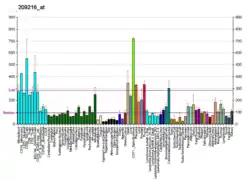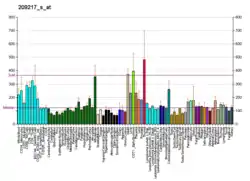WDR45
WD repeat domain phosphoinositide-interacting protein 4 (WIPI-4) is a protein that in humans is encoded by the WDR45 gene.[5][6] Mutations in this gene cause a distinct form of Neurodegeneration with brain iron accumulation (NBIA) called Beta-propeller protein-associated neurodegeneration (BPAN).[7]
| WDR45 | |||||||||||||||||||||||||||||||||||||||||||||||||||
|---|---|---|---|---|---|---|---|---|---|---|---|---|---|---|---|---|---|---|---|---|---|---|---|---|---|---|---|---|---|---|---|---|---|---|---|---|---|---|---|---|---|---|---|---|---|---|---|---|---|---|---|
| Identifiers | |||||||||||||||||||||||||||||||||||||||||||||||||||
| Aliases | WDR45, NBIA4, NBIA5, WDRX1, WIPI-4, WIPI4, JM5, WD repeat domain 45 | ||||||||||||||||||||||||||||||||||||||||||||||||||
| External IDs | OMIM: 300526 MGI: 1859606 HomoloGene: 48498 GeneCards: WDR45 | ||||||||||||||||||||||||||||||||||||||||||||||||||
| |||||||||||||||||||||||||||||||||||||||||||||||||||
| |||||||||||||||||||||||||||||||||||||||||||||||||||
| |||||||||||||||||||||||||||||||||||||||||||||||||||
| |||||||||||||||||||||||||||||||||||||||||||||||||||
| |||||||||||||||||||||||||||||||||||||||||||||||||||
| Wikidata | |||||||||||||||||||||||||||||||||||||||||||||||||||
| |||||||||||||||||||||||||||||||||||||||||||||||||||
Function
WIPI-4 is a member of the WD repeat protein family. WD repeats are minimally conserved regions of approximately 40 amino acids typically bracketed by gly-his and trp-asp (GH-WD), which may facilitate formation of heterotrimeric or multiprotein complexes. Members of this family are involved in a variety of cellular processes, including cell cycle progression, signal transduction, apoptosis, and gene regulation.
This gene WDR45 has a pseudogene at chromosome 4q31.3. Multiple alternatively spliced transcript variants encoding distinct isoforms have been found for this gene, but the biological validity and full-length nature of some variants have not been determined.[6]
Role in disease
De novo loss of function mutations in WDR45 were identified by exome sequencing in 20 patients with progressive neurodegeneration and evidence of iron on brain MRI scans.[7] The mutations cause an X-linked dominant form of NBIA now called Beta-propeller protein-associated neurodegeneration (BPAN).[7] A name for the disease before the gene was identified was called static encephalopathy of childhood with neurodegeneration in adulthood (SENDA), though this term is no longer used. There are no current treatments for BPAN, though medications and therapies can be used to treat symptoms.[8]
See also
References
- GRCh38: Ensembl release 89: ENSG00000196998 - Ensembl, May 2017
- GRCm38: Ensembl release 89: ENSMUSG00000039382 - Ensembl, May 2017
- "Human PubMed Reference:". National Center for Biotechnology Information, U.S. National Library of Medicine.
- "Mouse PubMed Reference:". National Center for Biotechnology Information, U.S. National Library of Medicine.
- Strausberg RL, Feingold EA, Grouse LH, Derge JG, Klausner RD, Collins FS, et al. (December 2002). "Generation and initial analysis of more than 15,000 full-length human and mouse cDNA sequences". Proceedings of the National Academy of Sciences of the United States of America. 99 (26): 16899–16903. Bibcode:2002PNAS...9916899M. doi:10.1073/pnas.242603899. PMC 139241. PMID 12477932.
- "Entrez Gene: WDR45 WD repeat domain 45".
- Haack TB, Hogarth P, Kruer MC, Gregory A, Wieland T, Schwarzmayr T, et al. (December 2012). "Exome sequencing reveals de novo WDR45 mutations causing a phenotypically distinct, X-linked dominant form of NBIA". American Journal of Human Genetics. 91 (6): 1144–1149. doi:10.1016/j.ajhg.2012.10.019. PMC 3516593. PMID 23176820.
This clinically recognizable disorder is among the more common forms of NBIA, and we suggest that it be named accordingly as beta-propeller protein-associated neurodegeneration.
- Spaull RV, Soo AK, Hogarth P, Hayflick SJ, Kurian MA (24 November 2021). "Towards Precision Therapies for Inherited Disorders of Neurodegeneration with Brain Iron Accumulation". Tremor and Other Hyperkinetic Movements. 11 (1): 51. doi:10.5334/tohm.661. PMC 8641530. PMID 34909266.
Further reading
- Proikas-Cezanne T, Waddell S, Gaugel A, Frickey T, Lupas A, Nordheim A (December 2004). "WIPI-1alpha (WIPI49), a member of the novel 7-bladed WIPI protein family, is aberrantly expressed in human cancer and is linked to starvation-induced autophagy". Oncogene. 23 (58): 9314–9325. doi:10.1038/sj.onc.1208331. PMID 15602573. S2CID 22642893.
- Jeffries TR, Dove SK, Michell RH, Parker PJ (June 2004). "PtdIns-specific MPR pathway association of a novel WD40 repeat protein, WIPI49". Molecular Biology of the Cell. 15 (6): 2652–2663. doi:10.1091/mbc.E03-10-0732. PMC 420090. PMID 15020712.
- Clark AG, Glanowski S, Nielsen R, Thomas PD, Kejariwal A, Todd MA, et al. (December 2003). "Inferring nonneutral evolution from human-chimp-mouse orthologous gene trios". Science. 302 (5652): 1960–1963. Bibcode:2003Sci...302.1960C. doi:10.1126/science.1088821. PMID 14671302. S2CID 6682593.
- Suzuki Y, Yoshitomo-Nakagawa K, Maruyama K, Suyama A, Sugano S (October 1997). "Construction and characterization of a full length-enriched and a 5'-end-enriched cDNA library". Gene. 200 (1–2): 149–156. doi:10.1016/S0378-1119(97)00411-3. PMID 9373149.
- Maruyama K, Sugano S (January 1994). "Oligo-capping: a simple method to replace the cap structure of eukaryotic mRNAs with oligoribonucleotides". Gene. 138 (1–2): 171–174. doi:10.1016/0378-1119(94)90802-8. PMID 8125298.





